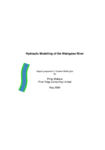Hydraulic Modelling of the Waingawa River
Search in document library
Purpose of the Report
To document hydraulic modelling of the Waingawa River, present flood maps and design flood levels, and support review of the river management scheme.
Geographic Area
The report covers the Waingawa River and its floodplain, from where it exits the hills to its confluence with the Ruamahanga River, Wairarapa, New Zealand.
Summary
This report was prepared to support a review of the Waingawa River Management Scheme by Greater Wellington Regional Council. It documents the hydraulic modelling of the Waingawa River, including the methods used, calibration, flood scenarios, and recommendations for future management.
The Waingawa River is a dynamic and complex waterway in the Wairarapa region. The modelling focused on the river reach from the hills to its confluence with the Ruamahanga River, including some of the adjacent floodplain. Earlier modelling in the 1990s used steady-state calculations, but the current study used MIKE FLOOD software, which combines one-dimensional and two-dimensional modelling to better represent the river and floodplain. This approach was necessary due to the river's changing channels, complex flood behaviour, and limited cross-section data.
Calibration of the model was based on the November 2006 flood, which had a peak flow of about 393 cubic metres per second at Kaituna. Adjustments were made for errors in survey data, particularly a 600 mm datum shift. The model's average error was about 2 cm, with an average absolute error of 18 cm. Some discrepancies in travel time were noted, with the model predicting slower flood movement than observed.
The model was used to simulate a range of flood scenarios, including 2, 5, 10, 20, 50, 100, and 1.5 times the 100-year flood events. Floodplain roughness was increased for larger floods to reflect changing conditions. Results included peak water levels, flows, velocities, and flood extent maps. The model also assessed the impact of stopbank breaches. For a 100-year flood, breaches had little additional effect, but for a 1.5 times 100-year flood, significant extra flooding was predicted, especially downstream of State Highway 2.
The report found that, despite uncertainties in data and modelling, the results are suitable for the purposes of river management. The floodable corridor is relatively narrow, and there are no major developments at risk under the scenarios considered. However, the report recommends improvements to future data collection, including additional cross-sections, confirming survey datums, extending LiDAR coverage, reinstating flow gauges, and recording debris marks after floods.
In summary, the report provides updated flood maps and design levels for the Waingawa River, supporting ongoing management and planning. It highlights the importance of accurate data and regular monitoring to improve flood risk understanding and resilience for the area.
